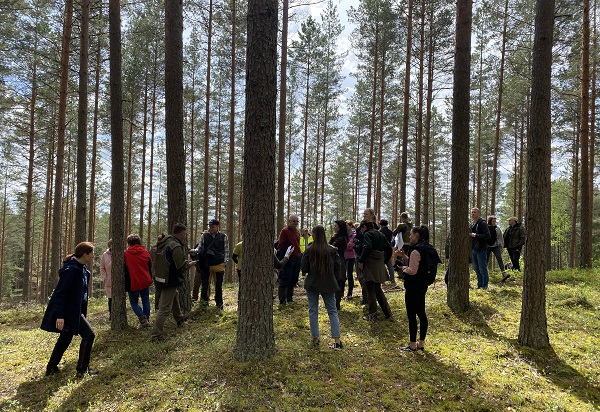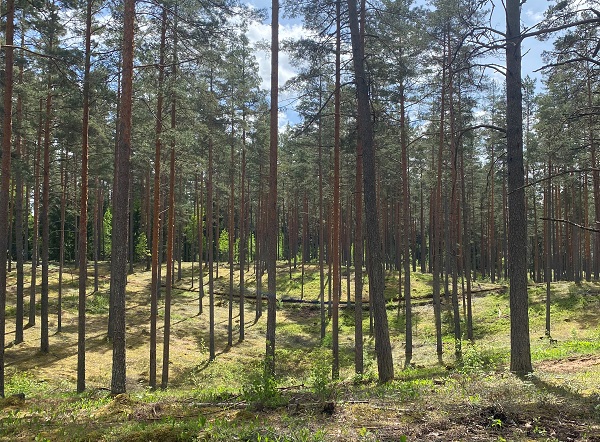LVM Organises an Informative Walk to Present the Works Carried out in the "Numernes valnis” Nature Park
JSC “Latvia's State Forests” (LVM) is carrying out important works for the diversification of the rare gravel and sand ridge forests and for providing sustainable existence of habitats of protected species in three specially protected natural areas; the works are scheduled to be completed by the end of 2023. The largest portion of works – 103 hectares out of a total of 178 hectares – was carried out in the “Numernes valnis” nature park, where an educational walk was held on 18 May to introduce the natural values, the works carried out in the park and their importance.
LVM employees involved in the work, representatives of the Nature Protection Board and the State Forest Service, as well as local residents and others interested took part in the walk. At several stops along the four-kilometre route, the involved specialists presented the work performed and the challenges that LVM specialists and service providers had to overcome.
The gravel and sand ridge forest habitat is a rare, light pine forest on the slopes that is home to rare and protected species. Gravel and sand ridge forests require natural disturbances such as wind, fire or regular disturbances in the ground cover that maintain open areas of sand and gravel. If these disturbances are missing, the forests gradually overgrow and the living conditions necessary for various plant and animal species disappear. That is why LVM has carried out important works to diversify the gravel and sand ridge forest.
In the course of the diversification of the gravel and sand ridge forest, weather was one of the biggest challenges in this place – in the “Numernes Valnis” nature park there was a snow cover up to 80 cm thick in the winter, which made it difficult to access the areas and carry out the work in full within the planned period of time. Once the snow had melted, the work areas had to be revisited, for example, to cut down the stumps that had remained too high when sawn in the winter.
It was especially difficult to carry out the work on the high and steep gravel and sand ridge slopes, which had to be cleared of unwanted trees with logging equipment, thus revealing the unique landscape characteristic of the gravel and sand ridge forest.
“We engaged only the most capable service providers to carry out the work, because the territory is very difficult due to both the terrain and the strict environmental conditions – the forest equipment moved only along specially and carefully planned technological corridors on the slopes from top to bottom in order to protect the deposits of important plant species. The steep slopes required courage and confidence on the part of the forest machine operators – the highest ridge, from which we had to carry out work on dangerous slopes, reaches almost 150 m,” says Dainis Babāns, Head of Logging in the Northern Latgale region of LVM.
This year, the branches and shoots cut in the gravel and sand ridge forest will still be collected with manual work.
One of the goals of the works is to improve the living conditions for the rare and protected species growing in the “Numernes valnis” nature park. Therefore, a series of forestry works have been carried out, such as thinning of undergrowth, tending of young stands, as well as burning of piles of branches in order to create open, sunlit areas and expose sand and gravel, which are important for the growth of the rare and sun-loving species that live here. This spring, LVM environmental specialists discovered 15 new forest pasqueflower deposits in the area of the work carried out, which proves that the work carried out has yielded the expected results.
Demonstration seminar in the “Numernes valnis” nature park
In the “Numernes valnis” nature park, trees and bushes disturbing the rare species of plants that love sun were cut down in an area of more than 90 hectares; the works also involved thinning of the undergrowth and the tending of young trees. Some of the felling residue was removed, while some was left in place to dry out during the summer. In the autumn, part of the branches collected in piles will be burnt on the spot, in order to create open, sunlit areas and expose the gravel. In turn, the other part of the collected branches will be taken out in the autumn to be chipped and delivered to local boiler houses as fuel. Such works, only on a smaller area of 13 hectares, were also carried out in the “Driksnas sils” nature park.
The educational walk began with a brief look at the pages of the history of the “Numernes valnis” area. Various interesting ancient and not so ancient events were presented by Inta Jurča, Head of the Kārsava Cultural History Centre “Līču mājas”, and Aldis Laganovskis, Head of Forest Management Planning in the Northern Latgale region of LVM. Under the guidance of a nature expert, the participants could get to know and learn to recognize the plant species found here and learn more about the conditions for the formation and existence of the gravel and sand ridge forest habitat. The walk also led to the place where at the end of April an LVM employee had discovered the rare earthstar Geastrum quadrifolium (mushroom), and here by joint effort one of the three informational boards was set up to inform about the works carried out in the area and give other valuable information. At the end of the event, the participants had a hearty lunch cooked on fire and captured the beautiful landscape of Latgale in photo moments.
The “Numernes valnis” and “Driksnas sils” nature parks are two of 14 specially protected natural areas, where LVM improves and restores habitats of EU importance; the works are scheduled to take place until the end of 2023 and are performed within the framework of the KHZ-SAM project “Management measures in specially protected natural areas and micro-reserves to improve the state of protection of habitats and species”. This project also contributes to creating suitable conditions for the sustainable existence of habitats of protected species. The leading partner of the project is the Nature Protection Board.















